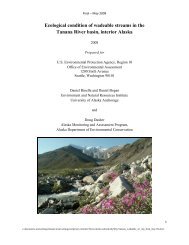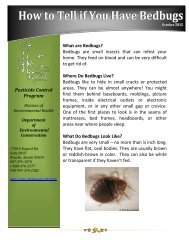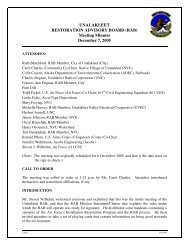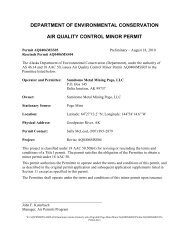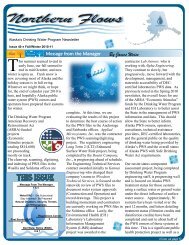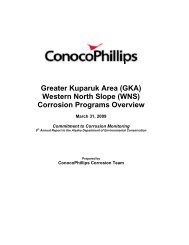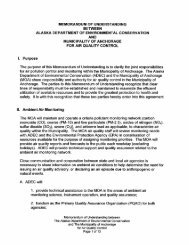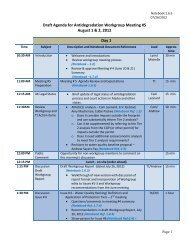2012 Ocean Ranger Guidebook Revision 3-7-12 - Alaska ...
2012 Ocean Ranger Guidebook Revision 3-7-12 - Alaska ...
2012 Ocean Ranger Guidebook Revision 3-7-12 - Alaska ...
You also want an ePaper? Increase the reach of your titles
YUMPU automatically turns print PDFs into web optimized ePapers that Google loves.
<strong>20<strong>12</strong></strong> <strong>Ocean</strong> <strong>Ranger</strong> <strong>Guidebook</strong> 3-7-<strong>12</strong><br />
(ii) Exception 2: Other conveyances. Garbage on or removed in the United States from a means of conveyance other than an aircraft is<br />
exempt from requirements under paragraph (c)(4) of this section if the following conditions are met when the garbage is on or removed from<br />
the means of conveyance:<br />
(A) The means of conveyance is accompanied by a certificate from an inspector stating the following:<br />
( 1 ) That the means of conveyance had previously been cleared of all garbage and of all meats and meat products, whatever the country of<br />
origin, except meats that are shelf-stable; all fresh and condensed milk and cream from countries designated in §94.1 as those in which footand-mouth<br />
disease exists; all fresh fruits and vegetables; and all eggs; and the items previously cleared from the means of conveyance as<br />
prescribed by this paragraph have been disposed of according to the procedures for disposing of regulated garbage, as specified in<br />
paragraphs (c)(4)(ii) and (c)(4)(iii) of this section.<br />
( 2 ) That the means of conveyance had then been cleaned and disinfected in the presence of the inspector; and<br />
(B) Since being cleaned and disinfected, the means of conveyance has not been in a non-Canadian foreign port.<br />
(4) Restrictions on regulated garbage. (i) Regulated garbage may not be disposed of, placed on, or removed from a means of conveyance<br />
except in accordance with this section.<br />
(ii) Regulated garbage is subject to general surveillance for compliance with this section by inspectors and to disposal measures authorized<br />
by the Plant Protection Act and the Animal Health Protection Act to prevent the introduction and dissemination of pests and diseases of<br />
plants and livestock.<br />
(iii) All regulated garbage must be contained in tight, covered, leak-proof receptacles during storage on board a means of conveyance while<br />
in the territorial waters, or while otherwise within the territory of the United States. All such receptacles shall be contained inside the guard<br />
rail if on a watercraft. Such regulated garbage shall not be unloaded from such means of conveyance in the United States unless such<br />
regulated garbage is removed in tight, covered, leak-proof receptacles under the direction of an inspector to an approved facility for<br />
incineration, sterilization, or grinding into an approved sewage system, under direct supervision by such an inspector, or such regulated<br />
garbage is removed for other handling in such manner and under such supervision as may, upon request in specific cases, be approved by<br />
the Administrator as adequate to prevent the introduction and dissemination of plant pests and animal diseases and sufficient to ensure<br />
compliance with applicable laws for environmental protection. Provided that, a cruise ship may dispose of regulated garbage in landfills<br />
at <strong>Alaska</strong>n ports only, if and only if the cruise ship does not have prohibited or restricted meat or animal products on board at the<br />
time it enters <strong>Alaska</strong>n waters for the cruise season, and only if the cruise ship, except for incidental travel through international<br />
waters necessary to navigate safely between ports, remains in Canadian and U.S. waters off the west coast of North America, and<br />
calls only at continental U.S. and Canadian ports during the entire cruise season.<br />
(A) Application for approval of a facility or sewage system may be made in writing by the authorized representative of any carrier or by the<br />
official having jurisdiction over the port or place of arrival of the means of conveyance to the Administrator, Animal and Plant Health<br />
Inspection Service, U.S. Department of Agriculture, Washington, DC 20250. The application must be endorsed by the operator of the facility<br />
or sewage system.<br />
(B) Approval will be granted if the Administrator determines that the requirements set forth in this section are met. Approval may be denied or<br />
withdrawn at any time, if the Administrator determines that such requirements are not met, after notice of the proposed denial or withdrawal<br />
of the approval and the reasons therefor, and an opportunity to demonstrate or achieve compliance with such requirements, has been<br />
afforded to the operator of the facility or sewage system and to the applicant for approval. However, approval may also be withdrawn without<br />
such prior procedure in any case in which the public health, interest, or safety requires immediate action, and in such case, the operator of<br />
the facility or sewage system and the applicant for approval shall promptly thereafter be given notice of the withdrawal and the reasons<br />
therefore and an opportunity to show cause why the approval should be reinstated.<br />
(iv) The Plant Protection and Quarantine Programs and Veterinary Services, Animal, and Plant Health Inspection Service, will cooperate with<br />
other Federal, State, and local agencies responsible for enforcing other statutes and regulations governing disposal of the regulated garbage<br />
to the end that such disposal shall be adequate to prevent the dissemination of plant pests and livestock or poultry diseases and comply with<br />
applicable laws for environmental protection. The inspectors, in maintaining surveillance over regulated garbage movements and disposal,<br />
shall coordinate their activities with the activities of representatives of the U.S. Environmental Protection Agency and other Federal, State,<br />
and local agencies also having jurisdiction over such regulated garbage.<br />
(d) Garbage generated in Hawaii —(1) Applicability. This section applies to garbage generated in households, commercial establishments,<br />
institutions, and businesses prior to interstate movement from Hawaii, and includes used paper, discarded cans and bottles, and food scraps.<br />
Such garbage includes, and is commonly known as, municipal solid waste.<br />
(i) Industrial process wastes, mining wastes, sewage sludge, incinerator ash, or other wastes from Hawaii that the Administrator determines<br />
do not pose risks of introducing animal or plant pests or diseases into the continental United States are not regulated under this section.<br />
(ii) The interstate movement from Hawaii to the continental United States of agricultural wastes and yard waste (other than incidental<br />
amounts (less than 3 percent) that may be present in municipal solid waste despite reasonable efforts to maintain source separation) is<br />
prohibited.<br />
103






